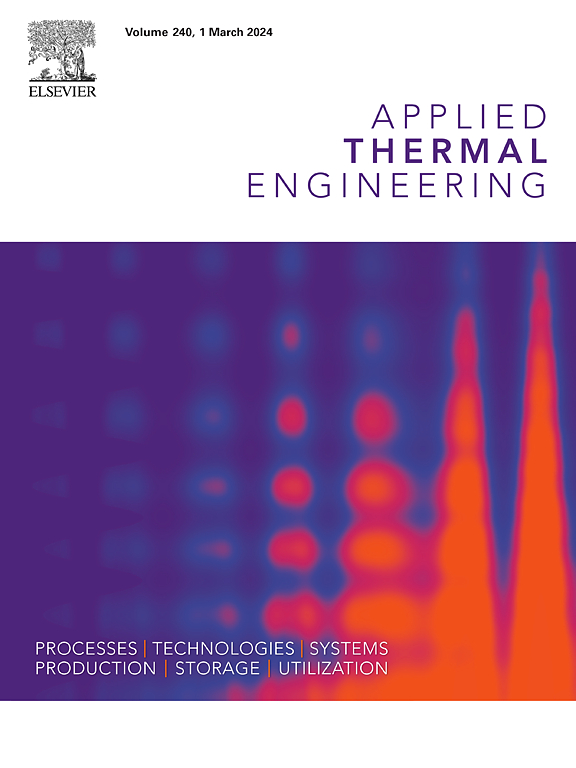亚音速-超音速混合流入条件下蒸发焰室的燃烧性能
IF 6.1
2区 工程技术
Q2 ENERGY & FUELS
引用次数: 0
摘要
火箭助推亚音速冲压式喷气发动机的燃烧过程代表了集成航空航天推进技术的一个重要进步,特别是对于嵌入式火箭系统而言。这些发动机有可能改善 25-35 千米高空的燃烧性能。然而,火箭射流和亚音速冲压喷气流之间巨大的温度和速度差限制了热量和质量的传递。研究亚音速-超音速混合条件下燃烧性能与入口参数之间的关系,为提高推力性能提供了一种可行的方法。本研究通过矩形通道中的平板剪切层引入亚音速和超音速气流混合,并在中央放置蒸发焰室以评估燃烧情况。结果表明,当当量比超过 0.2 时,燃烧效率会降低,而静态温度比对效率的影响很小,但对最大火焰稳定极限有很大影响。随着温度比从 1.30 增加到 1.80,火焰极限从 1.656 缩小到 0.237。较高的压力比最初会提高燃烧效率和火焰覆盖率,但最终会导致燃烧效率和火焰覆盖率下降。当压力比从 1.12 增加到 1.50 时,火焰极限从 0.900 扩大到 1.626。虽然马赫数的变化对效率影响不大,但火焰极限却呈现出先上升后下降的趋势。新发现包括非对称火焰模式和 "Z "形出口温度分布,有助于优化联合循环发动机的燃烧策略。本文章由计算机程序翻译,如有差异,请以英文原文为准。
Combustion performance of an evaporative flameholder under subsonic-supersonic mixing inflow
The combustion process in rocket-assisted subsonic ramjet engines represents a key advancement in integrated aerospace propulsion, particularly for embedded rocket-based systems. These engines offer the potential to improve combustion performance at altitudes of 25–35 km. However, the significant temperature and velocity differentials between the rocket jet and the subsonic ramjet flow restrict heat and mass transfer. Investigating the relationship between combustion performance and inlet parameters under subsonic-supersonic mixing conditions offers a promising approach to enhancing thrust performance. This study introduces subsonic and supersonic airflow mixing via a flat-plate shear layer in a rectangular channel, with an evaporative flameholder placed centrally to assess combustion. Results reveal that combustion efficiency decreases as the equivalence ratio exceeds 0.2, while the static temperature ratio has minimal impact on efficiency but strongly influences the maximum flame stabilization limit. As the temperature ratio increases from 1.30 to 1.80, the flame limit narrows from 1.656 to 0.237. Higher pressure ratios initially enhance combustion efficiency and flame coverage but eventually cause a decrease. The flame limit broadens from 0.900 to 1.626 as the pressure ratio increases from 1.12 to 1.50. While Mach number changes have little effect on efficiency, the flame limit exhibits an initial rise followed by a drop. Novel findings include an asymmetrical flame pattern and a “Z” shaped outlet temperature distribution, contributing to optimized combustion strategies for combined-cycle engines.
求助全文
通过发布文献求助,成功后即可免费获取论文全文。
去求助
来源期刊

Applied Thermal Engineering
工程技术-工程:机械
CiteScore
11.30
自引率
15.60%
发文量
1474
审稿时长
57 days
期刊介绍:
Applied Thermal Engineering disseminates novel research related to the design, development and demonstration of components, devices, equipment, technologies and systems involving thermal processes for the production, storage, utilization and conservation of energy, with a focus on engineering application.
The journal publishes high-quality and high-impact Original Research Articles, Review Articles, Short Communications and Letters to the Editor on cutting-edge innovations in research, and recent advances or issues of interest to the thermal engineering community.
 求助内容:
求助内容: 应助结果提醒方式:
应助结果提醒方式:


